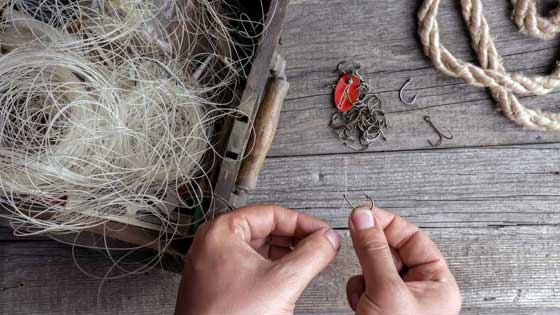Lure Accessories

Lure Accessories: what they are and how they work
Balancing flash and color for the lunker strike
Beads
The appeal behind beads comes from their ability to flash color and if dealing with salmon or trout, they can represent eggs. When crafting a beaded lure or fly, think about the weight of your beads.
For lures, you may be able to eliminate the need for a sinker. For a fly, too much weight may cause the fly to sink.
Be careful of the beads used as they may rattle when they touch and scare the fish away. However if well crafted, beads alone may be all that’s required on a hook.
Bucktail
Bucktail is simply deer hair. While used extensively in fly-fishing, buck tail is also effective in creating effective lures and considered prime fish attractors. However, other animal hair can easily be substituted for deer hair such as squirrel hair or any other animal that is fibrous.
Buck tail is highly versatility. It will catch any type of game fish from white perch to tuna. The main difference is the size of the lure and the style of retrieve. As with any lure, choose the correct size buck tail. Buck tails are most effective when worked on or very near the bottom or in the thermal range of your favorite fish.
Feathers
Features are simply that. They range from chicken and goose features to exotic foul and are used to create lures for both freshwater and saltwater fish. However, feathers are not as popular as hair, including synthetic fibers.
Flappers
Flappers are teardrop-shaped pieces of plastic and metal. They’re often brightly colored and come placed on many lures. However, too large and they can cause the lure to become unbalanced and create unrealistic movement. They’ll also attract a strike near the hook.
Fur, Feathers and Fuzzy Stuff
Most flies are made up of some type of fur, feathers or natural fuzz and some flies use a combination of all of these to create authentic flies. They can also be added to common lures and baits to create a more realistic lure.
 Marabou
Marabou
Marabou lures are very popular and successful at causing fish to strike. They’re excellent as they easily mimic a variety of aquatic and terrestrial food from sculpins, to leeches, grasshoppers, crickets, spent mayflies, emerging green drakes, stonefly nymphs, mice, tadpoles, dace, shiners and chubs to name a few.
We highly recommend this type of lure.
Plastics
Adding small plastic props to a lure can result in extra strikes. The most effective plastics are plastic worms and bait tails so something resembling a flat worm.
Skirts
Skirted lures are popular with spinnerbaits, which can be attributed to their durability and ability to catch fish. Made from rubber and vinyl, they offer greater durability over both natural and synthetic fibers.
Spinners
A spinner is a twisting blade, much like that of a propeller, but consisting of a single blade. Spinners are designed to call attention to the lure and cause a strike.
Synthetic Fibers
In recent years, synthetic fibers have begun to replace natural hair. This was done initially because of cost, but with the cost of oil in recent years, most manufacturers are switching back to natural fibers.
Synthetic fibers come in many grades and types to reflect the many different popular natural hairs. Rope is another synthetic fiber used to replicate animal hair in creating skirts for lures and flies.
Tapes
Fishing tape reminds us of the TV show, Red Green where duck tape is used to fix pretty much everything. However, fishing tape is for aesthetic and practical reasons as it dresses up the lure, comes in many colors, yet still functions as tape.
Tubing
Tubing is simply a small hollow tube that’s used to wrap the hook or part of a lure. These tubes are often made from bright plastic or latex tubing. While popular with some anglers, it’s not a very popular accessory. It’s not something we’ve experienced, as there are so many other interesting accessories to try.
Yarn
Yarn is used pretty much the same way as bucktail, rope and synthetic fibers although it’s slightly different. When added to spawn sacs, it can attract fish including salmon, trout and steelhead. To fix yarn to a hook, we recommend the use of a cinched hook.
Note: Be sure to use fluorescent tape for night fishing.
We need to stress the importance of the knowing basics first and foremost over accessorizing. Before going about accessorizing your lures, I recommend reading our section on Fish Attractants.



